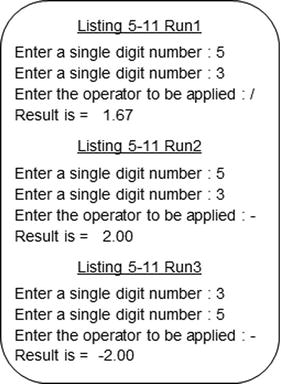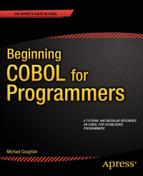![]()
The last chapter noted that programs that consist only of a sequence of statements are not very useful. To be useful, a program must use selection constructs to execute some statements rather than others and must use iteration constructs to execute certain statements repeatedly.
In this chapter, you examine the selection constructs available to COBOL. In addition to discussing the IF and EVALUATE statements, this chapter also discusses the condition types recognized by the selection constructs, the creation and use of condition names, the use of the SET verb to manipulate condition names, and the proper naming of condition names.
A number of short example programs are introduced in this chapter. Please keep in mind that these are only used to demonstrate particular language elements. They are not intended as realistic examples.
In most procedural languages, if and case/switch are the only selection constructs supported. COBOL supports advanced versions of both of these constructs, but it also supports a greater variety of condition types including relation conditions, class conditions, sign conditions, complex conditions, and condition names.
When a program runs, the program statements are executed one after another, in sequence, unless a statement is encountered that alters the order of execution. An IF statement is one of the statement types that can alter the order of execution in a program. It allows you to specify that a block of code is to be executed only if the condition attached to the IF statement is satisfied. The basic metalanguage for the IF statement is given in Figure 5-1.

Figure 5-1. Metalanguage for the IF statement/verb
The StatementBlock following the THEN executes, if the condition is true. The StatementBlock following the ELSE (if used) executes, if the condition is false. The StatementBlock(s) can include any valid COBOL statement including further IF constructs. This allows for nested IF statements.
One difference from many other programming languages is that when a condition is evaluated, it evaluates to either true or false. It does not evaluate to 1 or 0.
The explicit scope delimiter END-IF was introduced in ANS 85 COBOL. In the previous versions of COBOL, scope was delimited by means of the period. Although the scope of the IF statement may still be delimited by a period, the END-IF delimiter should always be used because it makes explicit the scope of the IF statement.
There are two problems with using a period as a scope delimiter:
- Periods are hard to see, and this makes it more difficult to understand the code.
- A period delimits all open scopes, and this is a source of many programming errors.
You explore this topic more fully later in the chapter.
The IF statement is not as simple as the metalanguage in Figure 5-1 seems to suggest. The condition that follows the IF is drawn from one of the condition types shown in Table 5-1. If a condition is not a complex condition, then it is regarded as a simple condition. A simple condition may be negated using the NOT keyword. Bracketing a complex condition causes it to be treated as a simple condition.
Table 5-1. Condition Types
Condition Type |
|---|
Relation |
Class |
Sign |
Complex |
Condition names |
Relation conditions are used to test whether a value is less than, equal to, or greater than another value. These conditions will be familiar to programmers of other languages. The use of words as shown in the relation condition metalanguage in Figure 5-2 may come as bit of a shock, but for most conditions the more familiar symbols (= < > >= <=) may be used. There is one exception to this: unlike in many other languages, in COBOL there is no symbol for NOT. You must use the word NOT if you want to express this condition.

Figure 5-2. Metalanguage for relation conditions
Note that the compared values must be type compatible. For instance, it is not valid to compare a string value to a numeric value. Some examples of relation conditions are shown in Example 5-1. Most of these examples are straight forward, but the final example includes an arithmetic expression. In this case, the arithmetic expression is evaluated and then the result is compared with the value in Num1.
Example 5-1. Some Sample Relation Conditions
IF Num1 < 10 THEN
DISPLAY "Num1 < 10"
END-IF
IF Num1 LESS THAN 10
DISPLAY "Num1 < 10"
END-IF
IF Num1 GREATER THAN OR EQUAL TO Num2
MOVE Num1 TO Num2
END-IF
IF Num1 < (Num2 + ( Num3 / 2))
MOVE ZEROS TO Num1
END-IF
A class condition does not refer to a class in the OO sense. Instead, it refers to the broad category or class (such as numeric, alphabetic, or alphabetic lower or upper) into which a data item may fall (see the metalanguage for class conditions in Figure 5-3). A class condition is used to discover whether the value of data item is a member of one these classes. For instance, a NUMERIC class condition might be used on an alphanumeric (PIC X) or a numeric (PIC 9) data item to see if it contained numeric data. Or an ALPHABETIC-UPPER class condition might be used to discover if a data item contained only capital letters (see Example 5-2).
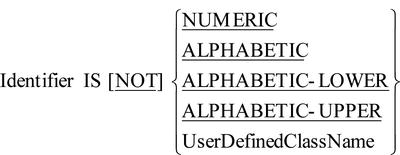
Figure 5-3. Metalanguage for class conditions
Example 5-2. Class Condition That Checks Whether the StateName Contains All Capitals
IF StateName IS ALPHABETIC-UPPER
DISPLAY "All the letters in StateName are upper case"
END-IF
Notes on Class Conditions
The target of a class test must be a data item with an explicit or implicit usage of DISPLAY. In the case of numeric tests, data items with a usage of PACKED-DECIMAL may also be tested.
The numeric test may not be used with data items described as alphabetic (PIC A) or with group items when any of the elementary items specifies a sign. An alphabetic test may not be used with any data items described as numeric (PIC 9).
The UserDefinedClassName is a name that you can assign to a set of characters. You must use the CLASS clause of the SPECIAL-NAMES paragraph, of the CONFIGURATION SECTION, in the ENVIRONMENT DIVISION, to assign a class name to a set of characters. A data item conforms to the UserDefinedClassName if its contents consist entirely of the characters listed in the definition of the UserDefinedClassName (see Listing 5-1 in the next section).
User-Defined Class Names
Whereas ALPHABETIC and NUMERIC are predefined class names that identify a subset of the character set, the UserDefinedClassName in the metalanguage (see Figure 5-3) is a name that you can assign to a defined subset of characters. To define the subset, you must create a CLASS entry in the SPECIAL-NAMES paragraph, of the CONFIGURATION SECTION, in the ENVIRONMENT DIVISION. The CLASS clause assigns a class name to a defined subset of characters. In a class condition, a data item conforms to the UserDefinedClassName if its contents consist entirely of the characters listed in the definition of the UserDefinedClassName.
Listing 5-1 is an example program that shows how to define and use a user-defined class name. In this listing, two class names are defined: HexNumber and RealName. HexNumber is used to test that NumIn contains only hex digits (0–9 and A–F). RealName is used to test that NameIn contains only valid characters. RealName was created because you can’t just use the IS ALPHABETIC class condition to test a name—sometimes names, especially Irish names, contain other characters; such as the apostrophe (’). RealName allows you to test that the name entered contains only characters from the set you have defined.
Listing 5-1. User-Defined Class Names Used with a Class Condition
IDENTIFICATION DIVISION.
PROGRAM-ID. Listing5-1.
AUTHOR. Michael Coughlan.
*> Shows how user defined class names are created and used
ENVIRONMENT DIVISION.
CONFIGURATION SECTION.
SPECIAL-NAMES.
CLASS HexNumber IS "0" THRU "9", "A" THRU "F"
CLASS RealName IS "A" THRU "Z", "a" THRU "z", "'", SPACE.
DATA DIVISION.
WORKING-STORAGE SECTION.
01 NumIn PIC X(4).
01 NameIn PIC X(15).
PROCEDURE DIVISION.
Begin.
DISPLAY "Enter a Hex number - " WITH NO ADVANCING
ACCEPT NumIn.
IF NumIn IS HexNumber THEN
DISPLAY NumIn " is a Hex number"
ELSE
DISPLAY NumIn " is not a Hex number"
END-IF
DISPLAY "----------------------------------"
DISPLAY "Enter a name - " WITH NO ADVANCING
ACCEPT NameIn
IF NameIn IS ALPHABETIC
DISPLAY NameIn " is alphabetic"
ELSE
DISPLAY NameIn " is not alphabetic"
END-IF
IF NameIn IS RealName THEN
DISPLAY NameIn " is a real name"
ELSE
DISPLAY NameIn " is not a real name"
END-IF
STOP RUN.
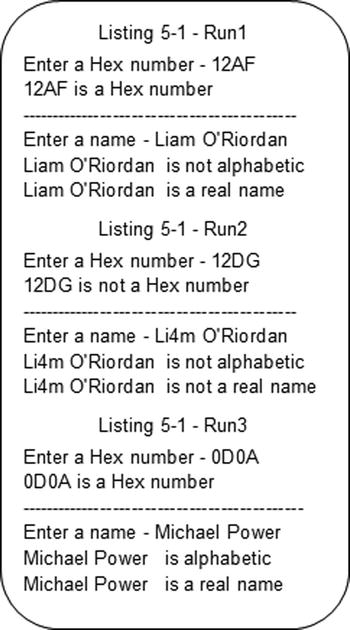
The program accepts a hex number from the user, tests that it contains only valid hex digits, and then displays the appropriate message. The program then accepts a name from the user, uses a class condition to test whether the contents are alphabetic, and displays the appropriate message. The program next tests that NameIn contains only the allowed characters and displays the appropriate message. To give you a feel for how the program works, I ran it a number of times and captured the output (see the output attached to Listing 5-1).
The sign condition (see the metalanguage in Figure 5-4) is used to discover whether the value of an arithmetic expression is less than, greater than, or equal to zero. Sign conditions are a shorter way of writing certain relation conditions.

Figure 5-4. Metalanguage for sign conditions
In Example 5-3, a sign condition is used to discover whether the result of evaluating an arithmetic expression is a negative value. This example also shows the equivalent relation condition.
Example 5-3. Sign Condition Used to Discover Whether a Result Is Negative
IF (Num2 * 10 / 50) - 10 IS NEGATIVE
DISPLAY "Calculation result is negative"
END-IF
*> the equivalent Relation Condition is
IF (Num2 * 10 / 50) - 10 LESS THAN ZERO
DISPLAY "Calculation result is negative"
END-IF
Unlike sign conditions and class conditions, complex conditions (sometimes called compound conditions) should be familiar to programmers of most languages. Even here, however, COBOL has a tweak—in the form of implied subjects—that you may find unusual. The metalanguage for complex conditions is given in Figure 5-5.

Figure 5-5. Metalanguage for complex conditions
Complex conditions are formed by combining two or more simple conditions using the conjunction operator OR or AND. Any condition (simple, complex, condition name) may be negated by preceding it with the word NOT. When NOT is applied to a condition, it toggles the true/false evaluation. For instance, if Num1 < 10 is true then NOT Num1 < 10 is false.
Like other conditions in COBOL, a complex condition evaluates to either true or false. A complex condition is an expression. Like arithmetic expressions, a complex condition is evaluated from left to right unless the order of evaluation is changed by precedence rules or by bracketing.
The precedence rules that apply to complex conditions are given in Table 5-2. To assist your understanding, the equivalent arithmetic precedence rules have been given alongside the condition rules.
Table 5-2. Precedence Rules
Precedence |
Condition Value |
Arithmetic Equivalent |
|---|---|---|
1 |
NOT |
** |
2 |
AND |
* or / |
3 |
OR |
+ or - |
Example 5-4. Complex Condition to Detect Whether the Cursor Is Onscreen
*> A complex condition example that detects if the cursor position located at
*> ScrnRow, ScrnCol is on screen (the text screen is 24 lines by 80 columns)
IF (ScrRow > 0 AND ScrRow < 25) AND (ScrCol > 0 AND ScrCol < 81) THEN
DISPLAY "On Screen"
END-IF
When a complex condition is being evaluated, it is useful to consider the OR and AND truth tables, shown in Table 5-3.
Table 5-3. OR and AND Truth Tables

Bracketing can make the order of evaluation explicit or can change it. Complex conditions are often difficult to understand, so any aid to clarity is welcome. For that reason, when you have to write a complex condition, you should always use bracketing to make explicit what is intended.
Consider the statement
IF NOT Num1 < 25 OR Num2 = 80 AND Num3 > 264 THEN
DISPLAY "Done"
END-IF
The rules of precedence govern how this IF statement is evaluated. You can leave it like this and hope that future readers will understand it, or you can assist their understanding by using bracketing to make explicit the order of evaluation already governed by those rules.
To apply bracketing, you note that NOT takes precedence, so you write (NOT Num1 < 25). AND is next according to the precedence rules, so you bracket the ANDed conditions to give (Num2 = 80 AND Num3 > 264). Finally, the OR is evaluated to give the full condition as
IF (NOT Num1 < 25) OR (Num2 = 80 AND Num3 > 264)THEN
DISPLAY "Done"
END-IF
Of course, you can use bracketing to change the order of evaluation. For instance, you can change the previous condition to
IF NOT (Num1 < 25 OR Num2 = 80) AND Num3 > 264 THEN
DISPLAY "Done"
END-IF
In the original condition, the order of evaluation was NOT..AND..OR, but the new bracketing changes that order to OR..NOT..AND. This change has a practical effect on the result of the condition.
Suppose all the simple conditions in the original expression are true. The truth table for that expression yields Table 5-4.
Table 5-4. IF Statement Evaluation When All the Simple Conditions Are True

The re-bracketed expression yields Table 5-5.
Table 5-5. The Rebracketed Truth Table

Although COBOL is often verbose, it does occasionally provide constructs that enable quite succinct statements to be written. The implied subject is one of those constructs.
When, in a complex condition, a number of comparisons have to be made against a single data item, it can be tedious to have to repeat the data item for each comparison. For instance, the example code fragment you saw earlier could be rewritten using implied subjects as
IF (ScrRow > 0 AND < 25) AND (ScrCol > 0 AND < 81) THEN
DISPLAY "On Screen"
END-IF
In this case, the implied subjects are ScrRow and ScrCol.
Similarly, using Grade = as the implied subject, you can rewrite
IF Grade = "A" OR Grade = "B" OR Grade = "C" THEN DISPLAY "Passed"
as
IF Grade = "A" OR "B" OR "C" THEN DISPLAY "Passed"
Finally, you can use the implied subject Num1 > to rewrite the expression
IF Num1 > Num2 AND Num1 > Num3 AND Num1 > Num4 THEN
DISPLAY "Num1 is the largest"
END-IF
as
IF Num1 > Num2 AND Num3 AND Num4
DISPLAY "Num1 is the largest"
END-IF
COBOL allows nested IF statements (see Example 5-5). But be aware that although nested IF statements may be easy to write, they are somewhat difficult to understand when you return to them after an interval of time. Complex, and nested IF, statements are often used as a substitute for clear thinking. When you first attempt to solve a problem, you often don’t have a full understanding of it. As a result, your solution may be convoluted and unwieldy. It is often only after you have attempted to solve the problem that you gain sufficient insight to allow you to generate a simpler solution. When you have a better understanding of the problem, you may find that a mere reorganization of your code will greatly reduce both the number and complexity of the IF statements required. Simplicity is difficult to achieve but is a highly desirable objective. It is a principle of good program design that your solution should be only as complex as the problem demands.
Example 5-5. Nested IF..ELSE Statements
*> This example uses nested IF statements including IF..THEN..ELSE statements
*> This is quite a straight forward example of nested IFs but nested If & IF.. ELSE statements
*> can get a lot more convoluted and difficult to understand. It is especially difficult if
*> some nested IF statements do not have ELSE branches and others do. It can take some time
*> to untangle which ELSE belongs with which IF
IF InputVal IS NUMERIC
MOVE InputVal to Num1
IF Num1 > 5 AND < 25
IF Num1 < Num2
MOVE Num2 TO Num1
ELSE
MOVE Num1 TO Num2
END-IF
DISPLAY "Num1 & Num2 = " Num1 SPACE Num2
ELSE
DISPLAY "Num 1 not in range"
END-IF
ELSE
DISPLAY "Input was not numeric"
END-IF
Delimiting Scope: END-IF vs. Period
The scope of an IF statement may be delimited by either an END-IF or a period (full stop). For a variety of reasons, the explicit END-IF delimiter should always be used instead of a period. The period is so problematic that one of the most useful renovations you can perform on legacy COBOL code is to replace the periods with explicit scope delimiters.
There are two main problems with using a period as a scope delimiter. The first is that periods are hard to see, which makes it more difficult to understand the code. The second problem is that a period delimits all open scopes. This is a source of many programming errors.
The code fragments in Example 5-6 illustrate the readability problem. Both IF statements are supposed to perform the same task. But the scope of the IF statement on the left is delimited by an END-IF, whereas the statement on the right is delimited by a period.
Example 5-6. Comparing END-IF and Period-Delimited IF Statements
Statement1 Statement1
Statement2 Statement2
IF Num1 > Num2 THEN IF Num1 > Num2 THEN
Statement3 Statement3
Statement4 Statement4
END-IF Statement5
Statement5 Statement6.
Statement6.
Unfortunately, on the right, the programmer has forgotten to follow Statement4 with a delimiting period. This means Statement5 and Statement6 will be included in the scope of the IF. They will be executed only if the condition is true. When periods are used to delimit the scope of an IF statement, this is an easy mistake to make; and, once made, it is difficult to spot. A period is small and unobtrusive compared to an END-IF.
The problem caused by unexpectedly delimiting scope is illustrated by the following code fragment:
IF Num1 < 10
ADD 10 TO Num1
MULTIPLY Num1 BY 1000 GIVING NUM2
ON SIZE ERROR DISPLAY "Error: Num2 too small".
DISPLAY "When is this shown?".
In this fragment, it looks as if the DISPLAY on the final line is executed only when Num1 is less than 10. However, a period has been used to delimit the scope of the ON SIZE ERROR (instead of an END-MULTIPLY delimiter), and that period also delimits the scope of the IF (all open scopes). This means the DISPLAY lies outside the scope of the IF and so is always executed.
If you replace the periods with explicit scope delimiters, you can see more clearly what is happening:
IF Num1 < 10
ADD 10 TO Num1
MULTIPLY Num1 BY 1000 GIVING NUM2
ON SIZE ERROR DISPLAY "Error: Num2 too small"
END-MULTIPLY
END-IF
DISPLAY "When is this shown?".
Even though the indentation used in this version is just as misleading as the period-based version, you are not misled. The explicit scope delimiters used for the IF and the MULTIPLY make the scope of these statements clear.
The use of delimiting periods in the PROCEDURE DIVISION is such a source of programming errors that a minimum period style of programming has been advocated by Howard Tompkins1 and Robert Baldwin2. In the examples in this book, I use a variation of the style suggested by Tompkins. Tompkins was writing before the 1985 standard was produced and so was not able to incorporate END delimiters into his scheme. Nowadays, you can adopt a style that uses only a single period per paragraph. Although Tompkins has persuasive arguments for placing that period alone on the line in column 12, for aesthetic reasons I use it to terminate the last statement in the paragraph. Whether you prefer the Tompkins lonely period style or my variation, I strongly suggest that you adopt the minimum period style. That way you will save yourself a world of hurt.
Wherever a condition tests a variable for equality to a value, a set of values, or a range of values, that condition can be replaced by a kind of abstract condition called a condition name. Wherever it is legal to have a condition, it is legal have a condition name. Just like a condition, a condition name is either true or false.
Condition names allow you to give a meaningful name to a condition while hiding the implementation details of how the condition is detected. For instance,
IF CountryCode = 3 OR 7 OR 10 OR 15 THEN
MOVE 14 TO CurrencyCode
END-IF
may be replaced with
IF BritishCountry THEN
SET CurrencyIsPound TO TRUE
END-IF
This example illustrates the readability benefits of using condition names. When you encounter code such as
IF CountryCode = 3 OR 7 OR 10 OR 15
the meaning of what the IF statement is testing is not obvious. You can see that CountryCode is being tested for particular values, but why? What is the significance of the values 3,7,10, and 15? What is the significance of moving 14 to the CurrencyCode? To discover this information, a maintenance programmer has to read external documentation or in-code comments. Now consider the condition name version of the IF statement. It is obvious what you are testing because the test has been given a meaningful name. Similarly, the action taken when BritishCountry is true is also obvious. No documentation and no comments are required.
Ease of maintenance is also improved. If the coding system changed and the countries of the British Isles were now represented by the codes 4, 12, 18, and 25, only the definition of the condition name would have to be changed. In the version that did not use the condition name, you would have to change the code values in all the places in the program where the condition was tested.
Condition names are sometimes called level 88s because they are created in the DATA DIVISION using the special level number 88. The metalanguage for defining condition names is given in Figure 5-6.

Figure 5-6. Metalanguage for defining condition names
Condition names are always associated with a particular data item and are defined immediately after the definition of that data item. A condition name may be associated with a group data item and elementary data, or even the element of a table. The condition name is automatically set to true or false the moment the value of its associated data item changes.
When the VALUE clause is used with condition names, it does not assign a value. Instead, it identifies the value(s) which, if found in the associated data item, make the condition name true.
When identifying the condition values, a single value, a list of values, a range of values, or any combination of these may be specified. To specify a list of values, the entries are listed after the keyword VALUE. The list entries may be separated by commas or spaces but must terminate with a period.
Single Condition Name, Single Value
In Example 5-7, the condition name CityIsLimerick has been associated with CityCode so that if CityCode contains the value 2 (listed in the CityIsLimerick VALUE clause), the condition name will be automatically set to true.
Example 5-7. Defining and Using a Condition Name
DATA DIVISION.
WORKING-STORAGE SECTION.
01 CityCode PIC 9 VALUE ZERO.
88 CityIsLimerick VALUE 2.
PROCEDURE DIVISION.
Begin.
: : : : : : : :
DISPLAY "Enter a city code (1-6) - " WITH NO ADVANCING
ACCEPT CityCode
IF CityIsLimerick
DISPLAY "Hey, we're home."
END-IF
: : : : : : : :
In the program fragment, DISPLAY and ACCEPT get a city code from the user. The instant the value in CityCode changes, the CityIsLimerick condition name will be set to true or false, depending on the value in CityCode.
Several condition names may be associated with a single data item. In Example 5-8, a number of condition names have been associated with CityCode. Each condition name is set to true when CityCode contains the value listed in the condition name VALUE clause. Condition names, like Booleans, can only take the value true or false. If a condition name is not set to true, it is set to false. Table 5-6 shows the Boolean value of each condition name for each value of CityCode.
Example 5-8. Associating Many Condition Names with a Data Item
DATA DIVISION.
WORKING-STORAGE SECTION.
01 CityCode PIC 9 VALUE ZERO.
88 CityIsDublin VALUE 1.
88 CityIsLimerick VALUE 2.
88 CityIsCork VALUE 3.
88 CityIsGalway VALUE 4.
88 CityIsSligo VALUE 5.
88 CityIsWaterford VALUE 6.
PROCEDURE DIVISION.
Begin.
: : : : : : : :
DISPLAY "Enter a city code (1-6) - " WITH NO ADVANCING
ACCEPT CityCode
IF CityIsLimerick
DISPLAY "Hey, we're home."
END-IF
IF CityIsDublin
DISPLAY "Hey, we're in the capital."
END-IF
: : : : : : : :
Table 5-6. Results for Each Value of CityCode

Overlapping and Multiple-Value Condition Names
When multiple condition names are associated with a single data item, more than one condition name can be true at the same time. In Listing 5-2, UniversityCity is true if CityCode contains any value between 1 and 4. These values overlap the values of the first four condition names, so if UniversityCity is true, then one of those four must also be true.
Listing 5-2. Multiple Condition Names with Overlapping Values
IDENTIFICATION DIVISION.
PROGRAM-ID. Listing5-2.
AUTHOR. Michael Coughlan.
DATA DIVISION.
WORKING-STORAGE SECTION.
01 CityCode PIC 9 VALUE ZERO.
88 CityIsDublin VALUE 1.
88 CityIsLimerick VALUE 2.
88 CityIsCork VALUE 3.
88 CityIsGalway VALUE 4.
88 CityIsSligo VALUE 5.
88 CityIsWaterford VALUE 6.
88 UniversityCity VALUE 1 THRU 4.
88 CityCodeNotValid VALUE 0, 7, 8, 9.
PROCEDURE DIVISION.
Begin.
DISPLAY "Enter a city code (1-6) - " WITH NO ADVANCING
ACCEPT CityCode
IF CityCodeNotValid
DISPLAY "Invalid city code entered"
ELSE
IF CityIsLimerick
DISPLAY "Hey, we're home."
END-IF
IF CityIsDublin
DISPLAY "Hey, we're in the capital."
END-IF
IF UniversityCity
DISPLAY "Apply the rent surcharge!"
END-IF
END-IF
STOP RUN.

The list of values that follows a condition name may be a single value, a number of values, or a range of values, or any mixture of these. When a range is specified, the word THROUGH or THRU is used to separate the minimum and maximum values in the range. In Listing 5-2, UniversityCity is true if CityCode contains any value between 1 and 4, whereas CityCodeNotValid is true if CityCode contains a value of 0 or 7 or 8 or 9. In Listing 5-2 I have chosen to list the individual values for CityCodeNotValid, but the value list could have been written as:
88 CityCodeNotValid VALUE 0, 7 THRU 9.
Table 5-7 shows the Boolean value of the condition names for each value of CityCode.
Table 5-7. Results for Each Value of CityCode
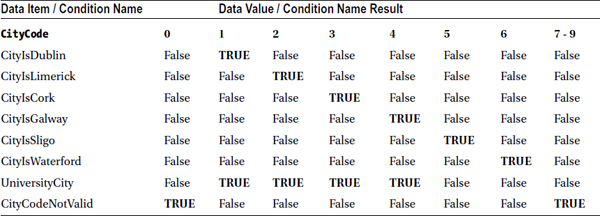
Values Can Be Alphabetic or Numeric
The list of values specified for a condition name can be numeric or alphabetic, as shown in Listing 5-3.
Listing 5-3. Multiple Condition Names with Overlapping Values
IDENTIFICATION DIVISION.
PROGRAM-ID. Listing5-3.
AUTHOR. Michael Coughlan.
DATA DIVISION.
WORKING-STORAGE SECTION.
01 InputChar PIC X.
88 Vowel VALUE "A","E","I","O","U".
88 Consonant VALUE "B" THRU "D", "F","G","H"
"J" THRU "N", "P" THRU "T"
"V" THRU "Z".
88 Digit VALUE "0" THRU "9".
88 ValidChar VALUE "A" THRU "Z", "0" THRU "9".
PROCEDURE DIVISION.
Begin.
DISPLAY "Enter a character :- " WITH NO ADVANCING
ACCEPT InputChar
IF ValidChar
DISPLAY "Input OK"
ELSE
DISPLAY "Invalid character entered"
END-IF
IF Vowel
DISPLAY "Vowel entered"
END-IF
IF Digit
DISPLAY "Digit entered"
END-IF
STOP RUN.
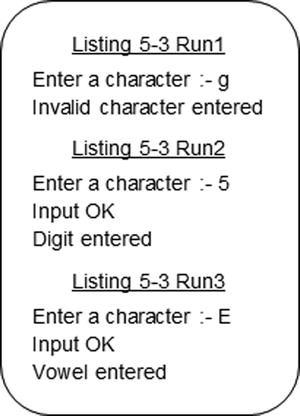
List Values Can Be Whole Words
Although I have used single characters in the examples so far, condition names are not restricted to values with only single characters. Whole words can be used if required, as shown in Listing 5-4.
Listing 5-4. Words as Value Items
IDENTIFICATION DIVISION.
PROGRAM-ID. Listing5-4.
AUTHOR. Michael Coughlan.
DATA DIVISION.
WORKING-STORAGE SECTION.
01 MakeOfCar PIC X(10).
88 VolksGroup VALUE "skoda", "seat",
"audi", "volkswagen".
88 GermanMade VALUE "volkswagen", "audi",
"mercedes", "bmw",
"porsche".
PROCEDURE DIVISION.
Begin.
DISPLAY "Enter the make of car - " WITH NO ADVANCING
ACCEPT MakeOfCar
IF VolksGroup AND GermanMade
DISPLAY "Your car is made in Germany by the Volkswagen Group."
ELSE
IF VolksGroup
DISPLAY "Your car is made by the Volkswagen Group."
END-IF
IF GermanMade
DISPLAY "Your car is made in Germany."
END-IF
END-IF
STOP RUN.
Using Condition Names Correctly
A condition name should express the true condition being tested. It should not express the test that sets the condition name to true. For instance, in Listing 5-2, a value of 1 in the data item CityCode indicates that the city is Dublin, a value of 2 means the city is Limerick, and so on. These condition names allow you to replace conditions such as
IF CityCode = 1
and
IF CityCode = 2
with the more meaningful statements
IF CityIsDublin
and
IF CityIsLimerick.
Many COBOL beginners would use condition names such as CityCodeIs1 or CityCodeIs2 to express these conditions. Those condition names are meaningless because they express the value that makes the condition name true instead of expressing the meaning or significance of CityCode containing a particular value. A value of 1 or 2 in CityCode is how you detect that the city is Dublin or Limerick. It is not the value of CityCode that ultimately interests you; it is the meaning or significance of that value.
Listing 5-5 is a small but complete program showing how the BritishCountry and CurrencyIsPound condition names might be defined and used. There is something unusual about this example, however. What do you imagine happens to the associated data item when the CurrencyIsPound condition name is set to true?
Listing 5-5. Detecting BritishCountry and Setting and Using CurrencyIsPound
IDENTIFICATION DIVISION.
PROGRAM-ID. Listing5-5.
AUTHOR. Michael Coughlan.
DATA DIVISION.
WORKING-STORAGE SECTION.
01 CountryCode PIC 999 VALUE ZEROS.
88 BritishCountry VALUES 3, 7, 10, 15.
01 CurrencyCode PIC 99 VALUE ZEROS.
88 CurrencyIsPound VALUE 14.
88 CurrencyIsEuro VALUE 03.
88 CurrencyIsDollar VALUE 28.
PROCEDURE DIVISION.
Begin.
DISPLAY "Enter the country code :- " WITH NO ADVANCING
ACCEPT CountryCode
IF BritishCountry THEN
SET CurrencyIsPound TO TRUE
END-IF
IF CurrencyIsPound THEN
DISPLAY "Pound sterling used in this country"
ELSE
DISPLAY "Country does not use sterling"
END-IF
STOP RUN.
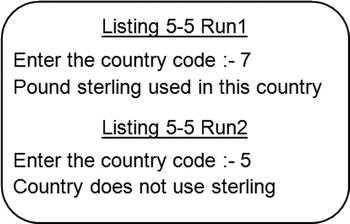
Setting a Condition Name to True
In Listing 5-5, the SET verb is used to set CurrencyIsPound to true. The way condition names normally work is that a value placed into the associated data item automatically sets the condition names that list that value to true. When a condition name is manually set to true using the SET verb, the value listed for that condition name is forced into the associated data item. In Listing 5-5, when the SET verb is used to set CurrencyIsPound to true, the value 14 is forced into CurrencyCode.
When a condition name that lists more than one value is set to true, the first of the values listed is forced into the associated data item. For instance, if BritishCountry were set to true, then the value 3 would be forced into CountryCode.
![]() ISO 2002 In standard ANS 85 COBOL, the SET verb cannot be used to set a condition name to false. This can be done in ISO 2002 COBOL, but in that case the level 88 entry must be extended to include the phrase
ISO 2002 In standard ANS 85 COBOL, the SET verb cannot be used to set a condition name to false. This can be done in ISO 2002 COBOL, but in that case the level 88 entry must be extended to include the phrase
WHEN SET TO FALSE IS LiteralValue$#
To set a condition name to true, you use the SET verb. You might think, therefore, that the SET verb is used only for manipulating condition names. But the SET verb is a strange fish. It is used for a variety of unconnected purposes. For instance, it is used to set a condition name to true. It is used to increment or decrement an index item. It is used to assign the value of an index to an ordinary data item and vice versa. It is used to set On or Off the switches associated with mnemonic names. In ISO 2002 COBOL, it is used to manipulate pointer variables (yes, ISO 2002 COBOL has pointers) and object references. It is often the target of implementer extensions.
Because the SET verb has so many different unrelated uses, instead of dealing with it as a single topic I discuss each format as you examine the construct to which it is most closely related.
Figure 5-7 shows the metalanguage for the version of the SET verb that is used to set a condition name to true. When the SET verb is used to set a condition name, the first condition value specified after the VALUE clause in the definition is moved to the associated data item. So setting the condition name to true changes the value of the associated data item. This can lead to some interesting data-manipulation opportunities.
![]()
Figure 5-7. Metalanguage for the SET verb condition name version
In summary, any operation that changes the value of the data item may change the status of the associated condition names, and any operation that changes the status of a condition name will change the value of its associated data item.
In ANS 85 COBOL, you cannot use the SET verb to set a condition name to false. But you can work around this restriction. Consider Example 5-9. This is more a pattern for processing sequential files than real COBOL code, but it serves to illustrate the point.
Example 5-9. Setting the EndOfFile Condition Name
01 EndOfFileFlag PIC 9 VALUE ZERO.
88 EndOfFile VALUE 1.
88 NotEndOfFile VALUE 0.
: : : : : : : :
READ InFile
AT END SET EndOfFile TO TRUE
END-READ
PERFORM UNTIL EndOfFile
Process Record
READ InFile
AT END SET EndOfFile TO TRUE
END-READ
END-PERFORM
Set NotEndOfFile TO TRUE.
In this example, the condition name EndOfFile has been set up to flag that the end of the file has been reached. You cannot set EndOfFile to false, but you can work around this problem by setting another condition name associated with the same data item to true. When EndOfFile is set to true, 1 is forced into the data item EndOfFileFlag, and this automatically sets NotEndOfFile to false. Similarly, when NotEndOfFile is set to true, 0 is forced into EndOfFileFlag, and this automatically sets EndOfFile to false.
Design Pattern: Reading a Sequential File
Because this is your first look at how COBOL processes sequential (as opposed to direct access) files, it might be useful to preview some of the material in Chapter 7 by providing a brief explanation now. The READ verb copies a record (a discrete package of data) from the file on backing storage and places it into an area of memory set up to store it. When the READ attempts to read a record from the file but discovers that the end of the file has been reached, it activates the AT END clause and executes whatever statements follow that clause.
Example 5-9 shows the pattern you generally use to process a stream of items when you can only discover that you have reached the end of the stream by attempting to read the next item. In this pattern, a loop processes the data in the stream. Outside the loop, you have a read to get the first item in the stream or to discover that the stream is empty. Inside the loop, you have statements to process the stream item and get the next item in the stream.
Why do you have this strange arrangement? The chief reason is that this arrangement allows you to place the read at the end of the loop body so that as soon as the end of the file is detected, the loop can be terminated. If you used a structure such as
PERFORM UNTIL EndOfFile
READ InFile
AT END SET EndOfFile TO TRUE
END-READ
Process Record
END-PERFORM
then when the end of file was detected, the program would still attempt to process the nonexistent record. Of course, the last valid record would still be in memory, so that last record would be processed twice. Many COBOL beginners make this programming error.
Many beginners attempt to solve this problem by only processing the record if the end of file has not been detected. They use a structure like this:
PERFORM UNTIL EndOfFile
READ InFile
AT END SET EndOfFile TO TRUE
END-READ
IF NOT EndOfFile
Process Record
END-IF
END-PERFORM
The problem with this arrangement is that the IF statement will be executed for every record in the file. Because COBOL often deals with very large data sets, this could amount to the execution of millions, maybe even hundreds of millions, of unnecessary statements. It is more elegant and more efficient to use what is called the read-ahead technique. The read-ahead has a read outside the loop to get the first record and a read inside the loop to get the remaining records. This approach has the added advantage of allowing the empty file condition to be detected before the loop is entered.
In Example 5-9, stand-alone condition names were used to flag the end-of-file condition. Because the EndOfFile condition name is closely related to the file, it would be better if the declaration of the condition name were kept with the file declaration. The example program in Listing 5-6 shows how that might be done. It also demonstrates how a condition name can be used with a group (as opposed to elementary) data item.
Listing 5-6. Reading a File and Setting the EndOfStudentFile Condition Name
IDENTIFICATION DIVISION.
PROGRAM-ID. Listing5-6.
AUTHOR. Michael Coughlan.
ENVIRONMENT DIVISION.
INPUT-OUTPUT SECTION.
FILE-CONTROL.
SELECT StudentFile ASSIGN TO "Listing5-6-TData.Dat"
ORGANIZATION IS LINE SEQUENTIAL.
DATA DIVISION.
FILE SECTION.
FD StudentFile.
01 StudentDetails.
88 EndOfStudentFile VALUE HIGH-VALUES.
02 StudentId PIC X(8).
02 StudentName PIC X(25).
02 CourseCode PIC X(5).
PROCEDURE DIVISION.
Begin.
OPEN INPUT StudentFile
READ StudentFile
AT END SET EndOfStudentFile TO TRUE
END-READ
PERFORM UNTIL EndOfStudentFile
DISPLAY StudentName SPACE StudentId SPACE CourseCode
READ StudentFile
AT END SET EndOfStudentFile TO TRUE
END-READ
END-PERFORM
CLOSE StudentFile
STOP RUN.

In Listing 5-6, the condition name EndOfStudentFile is associated with the group item (which also happens to be a record) StudentDetails. When EndOfStudentFile is set to true, the entire StudentDetails area of storage (38 characters) is flushed with highest possible character value.
This arrangement has two major advantages:
- The EndOfStudentFile condition name is kept with its associated file.
- Flushing the record with HIGH-VALUES at the end of the file eliminates the need for an explicit condition when doing a key-matching update of a sequential file.
When you become aware that setting a condition name forces a value into the associated data item, it is tempting to see just how far you can take this idea. Listing 5-7 takes advantage of the way condition names work to automatically move an appropriate error message into a message buffer. The program is just a stub to test this error-messaging idea; it doesn’t actually validate the date. Instead, the user manually enters one of the codes that would be returned by the date-validation routine.
Listing 5-7. Using Condition Names to Set Up a Date-Validation Error Message
IDENTIFICATION DIVISION.
PROGRAM-ID. Listing5-7.
AUTHOR. Michael Coughlan.
DATA DIVISION.
WORKING-STORAGE SECTION.
01 ValidationReturnCode PIC 9.
88 DateIsOK VALUE 0.
88 DateIsInvalid VALUE 1 THRU 8.
88 ValidCodeSupplied VALUE 0 THRU 8.
01 DateErrorMessage PIC X(35) VALUE SPACES.
88 DateNotNumeric VALUE "Error - The date must be numeric".
88 YearIsZero VALUE "Error - The year cannot be zero".
88 MonthIsZero VALUE "Error - The month cannot be zero".
88 DayIsZero VALUE "Error - The day cannot be zero".
88 YearPassed VALUE "Error - Year has already passed".
88 MonthTooBig VALUE "Error - Month is greater than 12".
88 DayTooBig VALUE "Error - Day greater than 31".
88 TooBigForMonth VALUE "Error - Day too big for this month".
PROCEDURE DIVISION.
Begin.
PERFORM ValidateDate UNTIL ValidCodeSupplied
EVALUATE ValidationReturnCode
WHEN 0 SET DateIsOK TO TRUE
WHEN 1 SET DateNotNumeric TO TRUE
WHEN 2 SET YearIsZero TO TRUE
WHEN 3 SET MonthIsZero TO TRUE
WHEN 4 SET DayIsZero TO TRUE
WHEN 5 SET YearPassed TO TRUE
WHEN 6 SET MonthTooBig TO TRUE
WHEN 7 SET DayTooBig TO TRUE
WHEN 8 SET TooBigForMonth TO TRUE
END-EVALUATE
IF DateIsInvalid THEN
DISPLAY DateErrorMessage
END-IF
IF DateIsOK
DISPLAY "Date is Ok"
END-IF
STOP RUN.
ValidateDate.
DISPLAY "Enter a validation return code (0-8) " WITH NO ADVANCING
ACCEPT ValidationReturnCode.
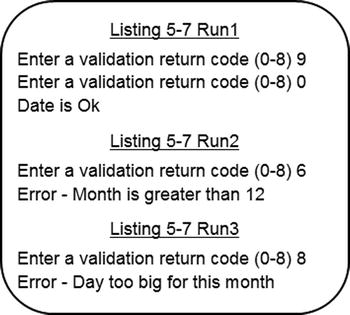
In Listing 5-7, the EVALUATE verb is used to SET a particular condition name depending on the value in the ValidationReturnCode data item. You probably did not have much difficulty working out what the EVALUATE statement is doing because it has echoes of how the switch/case statement works in other languages. Ruby programmers, with their when-branched case statement, were probably particularly at home. But the resemblance of EVALUATE to the case/switch used in other languages is superficial. EVALUATE is far more powerful than these constructs. Even when restricted to one subject, EVALUATE is more powerful because it is not limited to ordinal types. When used with multiple subjects, EVALUATE is a significantly more powerful construct. One common use for the multiple-subject EVALUATE is the implementation of decision-table logic.
A decision table is a way to model complicated logic in a tabular form. Decision tables are often used by systems analysts to express business rules that would be too complicated and/or too confusing to express in a textual form.
For instance, suppose an amusement park charges different admission fees depending on the age and height of visitors, according to the following rules:
- If the person is younger than 4 years old, admission is free.
- If the person is between 4 and 7, admission is $10.
- If between 8 and 12, admission is $15.
- If between 13 and 64, admission is $25.
- If 65 or older, admission is $10.
- In addition, in view of the height restrictions on many rides, persons shorter than 48 inches who are between the ages of 8 and 64 receive a discount. Persons between 8 and 12 are charged a $10 admission fee, whereas those between the ages of 13 and 64 are charged $18.
You can represent this textual specification using the decision table in Table 5-8.
Table 5-8. Amusement Park Decision Table
Age |
Height in inches |
Admission |
|---|---|---|
< 4 |
NA |
$0 |
4 - 7 |
NA |
$10 |
8 - 12 |
Height >= 48 |
$15 |
8 - 12 |
Height < 48 |
$10 |
13 - 64 |
Height >= 48 inches |
$25 |
13 - 64 |
Height < 48 |
$18 |
>= 65 |
NA |
$10 |
The EVALUATE metalanguage (see Figure 5-8) looks very complex but is actually fairly easy to understand. It is, though, somewhat difficult to explain in words, so I mainly use examples to explain how it works.
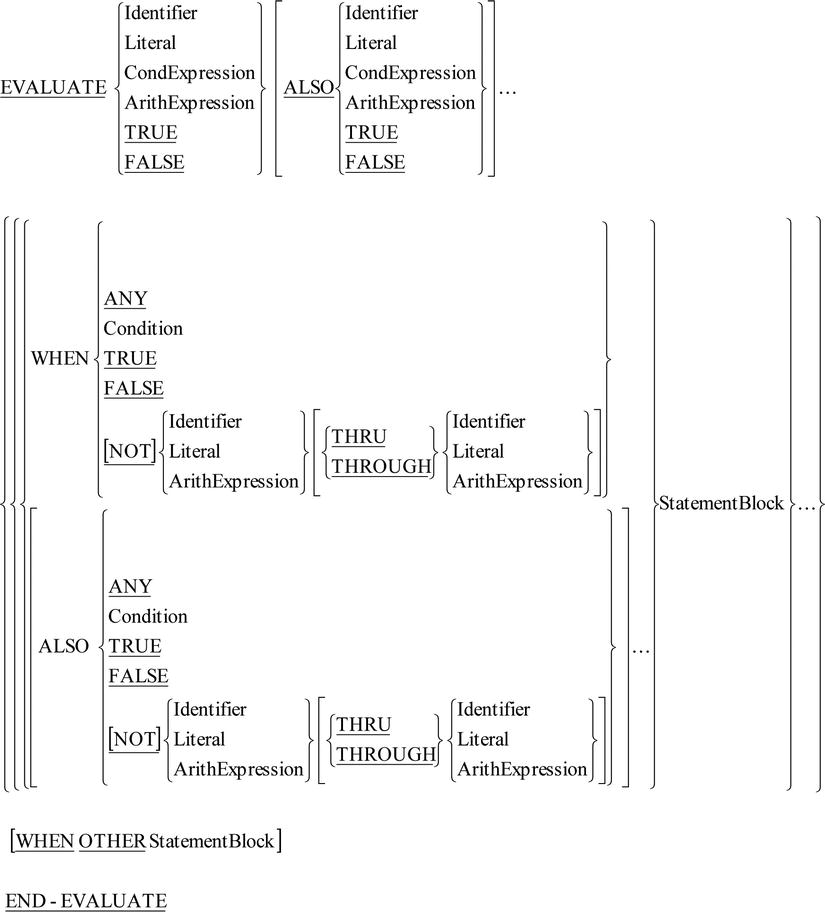
Figure 5-8. Metalanguage for the EVALUATE verb
Notes
The following are the WHEN branch rules:
- Only one WHEN branch is chosen per execution of EVALUATE.
- The order of the WHEN branches is important because checking of the branches is done from top to bottom.
- If any WHEN branch is chosen, the EVALUATE ends. The break required in other languages to stop execution of the remaining branches is not required in COBOL.
- If none of the WHEN branches can be chosen, the WHEN OTHER branch (if it exists) is executed.
- If none of the WHEN branches can be chosen, and there is no WHEN OTHER phrase, the EVALUATE simply terminates.
The items immediately after the word EVALUATE and before the first WHEN are called subjects. The items between the WHEN and its statement block are called objects.
The number of subjects must equal the number of objects, and the objects must be compatible with the subjects. For instance, if the subject is a condition, then the object must be either TRUE or FALSE. If the subject is a data item, then the object must be either a literal value or a data item.
Table 5-9 lists the combinations you may have. If there are four subjects, then each WHEN branch must list four objects. If the value of a particular object does not matter, the keyword ANY may be used.
Table 5-9. EVALUATE Subject/Object Combinations

EVALUATE Examples
This section looks at three examples of the EVALUATE verb.
Shoppers choose the method of payment as Visa, MasterCard, American Express, Check, or Cash. A program totals the amount paid by each payment method. After a sale, the sale value is added to the appropriate total. Condition names (ByVisa, ByMasterCard, ByAmericanExpress, ByCheck, ByCash) have been set up for each of the payment methods.
You could code this as follows:
IF ByVisa ADD SaleValue TO VisaTotal
ELSE
IF ByMasterCard ADD SaleValue TO MasterCardTotal
ELSE
IF ByAmericanExpress ADD SaleValue TO AmericanExpressTotal
ELSE
IF ByCheck ADD SaleValue TO CheckTotal
ELSE
IF ByCash ADD SaleValue TO CashTotal
END-IF
END-IF
END-IF
END-IF
END-IF
You can replace these nested IF statements with the neater and easier-to-understand EVALUATE statement:
EVALUATE TRUE
WHEN ByVisa ADD SaleValue TO VisaTotal
WHEN ByMasterCard ADD SaleValue TO MasterCardTotal
WHEN ByAmericanExpress ADD SaleValue TO AmericanExpressTotal
WHEN ByCheck ADD SaleValue TO CheckTotal
WHEN ByCash ADD SaleValue TO CashTotal
END-EVALUATE
In this example, the objects must all be either conditions or condition names, because the subject is TRUE.
EVALUATE can be used to encode a decision table. Listing 5-8 shows how the Amusement Park decision table from Table 5-8 might be encoded.
Listing 5-8. Amusement Park Admission
IDENTIFICATION DIVISION.
PROGRAM-ID. Listing5-8.
DATA DIVISION.
WORKING-STORAGE SECTION.
01 Age PIC 99 VALUE ZERO.
88 Infant VALUE 0 THRU 3.
88 YoungChild VALUE 4 THRU 7.
88 Child VALUE 8 THRU 12.
88 Visitor VALUE 13 THRU 64.
88 Pensioner VALUE 65 THRU 99.
01 Height PIC 999 VALUE ZERO.
01 Admission PIC $99.99.
PROCEDURE DIVISION.
Begin.
DISPLAY "Enter age :- " WITH NO ADVANCING
ACCEPT Age
DISPLAY "Enter height :- " WITH NO ADVANCING
ACCEPT Height
EVALUATE TRUE ALSO TRUE
WHEN Infant ALSO ANY MOVE 0 TO Admission
WHEN YoungChild ALSO ANY MOVE 10 TO Admission
WHEN Child ALSO Height >= 48 MOVE 15 TO Admission
WHEN Child ALSO Height < 48 MOVE 10 TO Admission
WHEN Visitor ALSO Height >= 48 MOVE 25 TO Admission
WHEN Visitor ALSO Height < 48 MOVE 18 TO Admission
WHEN Pensioner ALSO ANY MOVE 10 TO Admission
END-EVALUATE
DISPLAY "Admission charged is " Admission
STOP RUN.
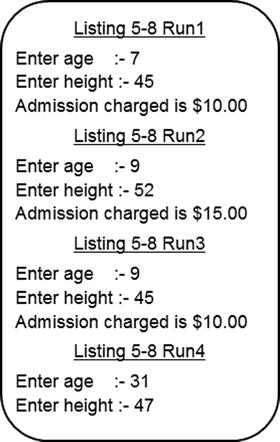
The Acme Book Club is the largest online book club in the world. The book club sells books to both members and non-members all over the world. For each order, Acme applies a percentage discount based on the quantity of books in the current order, the value of books purchased in the last three months (last quarter), and whether the customer is a member of the Book Club.
Acme uses the decision table in Table 5-10 to decide what discount to apply. Listing 5-9 is a small test program that uses EVALUATE to implement the decision table.
Table 5-10. Acme Book Club Discount Decision Table

Listing 5-9. Acme Book Club Example
IDENTIFICATION DIVISION.
PROGRAM-ID. Listing5-9.
AUTHOR. Michael Coughlan.
DATA DIVISION.
WORKING-STORAGE SECTION.
01 Member PIC X VALUE SPACE.
01 QP PIC 9(5) VALUE ZEROS.
*> QuarterlyPurchases
01 Qty PIC 99 VALUE ZEROS.
01 Discount PIC 99 VALUE ZEROS.
PROCEDURE DIVISION.
Begin.
DISPLAY "Enter value of QuarterlyPurchases - " WITH NO ADVANCING
ACCEPT QP
DISPLAY "Enter qty of books purchased - " WITH NO ADVANCING
ACCEPT Qty
DISPLAY "club member enter Y or N - " WITH NO ADVANCING
ACCEPT Member
EVALUATE Qty ALSO TRUE ALSO Member
WHEN 1 THRU 5 ALSO QP < 500 ALSO ANY MOVE 0 TO Discount
WHEN 1 THRU 5 ALSO QP < 2000 ALSO "Y" MOVE 7 TO Discount
WHEN 1 THRU 5 ALSO QP < 2000 ALSO "N" MOVE 5 TO Discount
WHEN 1 THRU 5 ALSO QP >= 2000 ALSO "Y" MOVE 10 TO Discount
WHEN 1 THRU 5 ALSO QP >= 2000 ALSO "N" MOVE 8 TO Discount
WHEN 6 THRU 20 ALSO QP < 500 ALSO "Y" MOVE 3 TO Discount
WHEN 6 THRU 20 ALSO QP < 500 ALSO "N" MOVE 2 TO Discount
WHEN 6 THRU 20 ALSO QP < 2000 ALSO "Y" MOVE 12 TO Discount
WHEN 6 THRU 20 ALSO QP < 2000 ALSO "N" MOVE 10 TO Discount
WHEN 6 THRU 20 ALSO QP >= 2000 ALSO "Y" MOVE 25 TO Discount
WHEN 6 THRU 20 ALSO QP >= 2000 ALSO "N" MOVE 15 TO Discount
WHEN 21 THRU 99 ALSO QP < 500 ALSO "Y" MOVE 5 TO Discount
WHEN 21 THRU 99 ALSO QP < 500 ALSO "N" MOVE 3 TO Discount
WHEN 21 THRU 99 ALSO QP < 2000 ALSO "Y" MOVE 16 TO Discount
WHEN 21 THRU 99 ALSO QP < 2000 ALSO "N" MOVE 15 TO Discount
WHEN 21 THRU 99 ALSO QP >= 2000 ALSO "Y" MOVE 30 TO Discount
WHEN 21 THRU 99 ALSO QP >= 2000 ALSO "N" MOVE 20 TO Discount
END-EVALUATE
DISPLAY "Discount = " Discount "%"
STOP RUN.

Summary
The three classic constructs of structured programming are sequence, selection, and iteration. You have already noted that a COBOL program starts execution with the first statement in the PROCEDURE DIVISION and then continues to execute the statements one after another in sequence until the STOP RUN or the end-of-the-program text is encountered, unless some other statement changes the order of execution. In this chapter, you examined the IF and EVALUATE statements. These statements allow a program to selectively execute program statements. In the next chapter, you discover how iteration, the final classic construct, is implemented in COBOL.
References
1. Tompkins HE. In defense of teaching structured COBOL as computer science (or, notes on being sage struck). ACM SIGPLAN Notices. 1983; 18(4): 86-94.
2. Baldwin RR. A note on H.E. Tompkins’s minimum-period COBOL style. ACM SIGPLAN Notices. 1987; 22(5): 27-31. http://doi.acm.org/10.1145/25267.25273
doi: 10.1145/25267.25273
Getting out your 2B pencil once more, write answers to the following questions.
- For each of the following condition names, which do you consider to be inappropriately named? Suggest more suitable names for these only.
01 Country-Code PIC XX.
88 Code-Is-US VALUE "US".
____________________________________________________________
01 Operating-System PIC X(15).
88 Windows-Or-UNIX VALUE "WINDOWS".
____________________________________________________________
01 Room-Type PIC X(20).
88 Double-Room VALUE "DOUBLE".
____________________________________________________________
88 Single-Room VALUE "SINGLE".
____________________________________________________________ - Write an IF statement that uses the SET verb to manually set the condition name InvalidCode to true if DeptCode contains anything except 1, 6, or 8.
___________________________________________________________________
___________________________________________________________________
___________________________________________________________________
___________________________________________________________________
___________________________________________________________________
___________________________________________________________________
- Assume the variable DeptCode in question 2 is described as
01 DeptCode PIC 9.
______________________________________________________________________
Write a level 88 condition name called InvalidCode that is automatically set to true when the statement ACCEPT DeptCode accepts any value other than 1, 6, or 8.
- In each of the following five groups of skeleton IF statements, state whether the statements in each group have the same effect (in the sense that they evaluate to true or false). Answer yes or no.
Do these statements have the same effect? Answer
IF Num1 = 1 OR Num1 NOT = 1...
IF NOT (Num1 = 1 AND Num1 = 2) ...
IF TransCode IS NOT = 3 OR Total NOT > 2550 ...
IF NOT (TransCode IS = 3 OR Total > 2550) ...
IF Num1 = 31 OR Num2 = 12 AND Num3 = 23 OR Num4 = 6 ...
IF (Num1 = 31 OR (Num2 = 12 AND Num3 = 23)) OR Num4 = 6 ...
IF Num1 = 15 OR Num1 = 12 OR Num1 = 7 AND City = "Cork" ...
IF (Num1 = 15 OR Num1 = 12 OR Num1 = 7) AND City = "Cork" ...
IF (Num1 = 1 OR Num1 = 2) AND (Num2 = 6 OR Num2 = 8) ...
IF Num1 = 1 OR Num1 = 2 AND Num2 = 6 OR Num2 = 8 ... - Write an EVALUATE statement to implement the decision part of a game of rock, paper, scissors. Most of the program has been written for you. Just complete the EVALUATE. ADD a WHEN OTHER branch to the EVALUATE to detect when a player enters a code other than 1, 2, or 3.
IDENTIFICATION DIVISION.
PROGRAM-ID. Listing5-10.
AUTHOR. Michael Coughlan.
DATA DIVISION.
WORKING-STORAGE SECTION.
01 PlayerGuess-A PIC 9 VALUE 1.
88 Rock-A VALUE 1.
88 Paper-A VALUE 2.
88 Scissors-A VALUE 3.
01 PlayerGuess-B PIC 9 VALUE 2.
88 Rock-B VALUE 1.
88 Paper-B VALUE 2.
88 Scissors-B VALUE 3.
PROCEDURE DIVISION.
BEGIN.
DISPLAY "Guess for player A (1=rock, 2=scissors, 3=paper) : "
WITH NO ADVANCING
ACCEPT PlayerGuess-A
DISPLAY "Guess for player B (1=rock, 2=scissors, 3=paper) : "
WITH NO ADVANCING
ACCEPT PlayerGuess-BEVALUATE_____________________________________________________
______________________________________________________________
______________________________________________________________
______________________________________________________________
______________________________________________________________
______________________________________________________________
______________________________________________________________
______________________________________________________________
______________________________________________________________
______________________________________________________________
______________________________________________________________
______________________________________________________________
______________________________________________________________
PROGRAMMING EXERCISE
Listing 4-2 is a program that accepts two numbers from the user, multiplies them together, and then displays the result. Modify the program so that
- It also accepts an operator symbol (+ - / *).
- It uses EVALUATE to discover which operator has been entered and to apply that operator to the two numbers entered.
- It uses the condition name ValidOperator to identify the valid operators and only displays the result if the operator entered is valid.
- The Result data item is changed to accommodate the possibility that subtraction may result in a negative value.
- The Result data item is changed to accommodate the decimal fractions that may result from division. The result data item should be able to accept values with up to two decimal places (for example, 00.43 or 00.74).
LANGUAGE KNOWLEDGE EXERCISES—ANSWERS
- For each of the following condition names, which do you consider to be inappropriately named? Suggest more suitable names for these only.
01 Country-Code PIC XX.
88 UnitedStates VALUE "US".
* Change
* Example of use - IF UnitedStates DISPLAY "We are in America" END-IF
01 Operating-System PIC X(15).
88 Windows VALUE " WINDOWS".
* Change
* Example of use - IF Windows DISPLAY "Windows is best" END-IF
01 Room-Type PIC X(20).
88 Double-Room VALUE "DOUBLE".
88 Single-Room VALUE "SINGLE".
* No change.
* Example of use -IF Double-Room ADD DoubleRoomSurchage TO RoomRent END-IF - Write an IF statement that uses the SET verb to manually set the condition name InvalidCode to true if DeptCode contains anything except 1, 6, or 8.
IF NOT (DeptCode = 1 OR DeptCode = 6 OR DeptCode = 8) THEN
SET InvalidCode TO TRUE
END-IF.Or, using implied subjects:
IF NOT (DeptCode = 1 OR 6 OR 8) THEN
SET InvalidCode TO TRUE
END-IF. - Assume the variable DeptCode in question 2 is described as
01 DeptCode PIC 9.
88 InvalidCode VALUE 0, 2 THRU 5,7,9.Write a level 88 condition name called InvalidCode that is automatically set to true when the statement ACCEPT DeptCode accepts any value other than 1, 6, or 8.
- In each of the following five groups of skeleton IF statements, state whether the statements in each group have the same effect (in the sense that they evaluate to true or false). Answer yes or no.
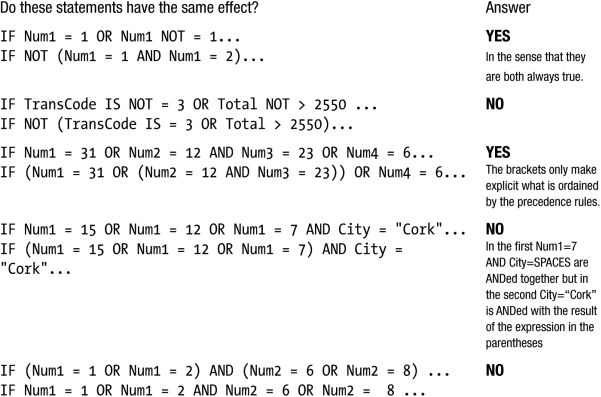
- Write an EVALUATE statement to implement the decision part of a game of rock, paper, scissors. Most of the program has been written for you. Just complete the EVALUATE. ADD a WHEN OTHER branch to the EVALUATE to detect when a player enters a code other than 1, 2, or 3.
Listing 5-10. Rock, Paper, Scissors Game
IDENTIFICATION DIVISION.
PROGRAM-ID. Listing5-10.
AUTHOR. Michael Coughlan.
DATA DIVISION.
WORKING-STORAGE SECTION.
01 PlayerGuess-A PIC 9 VALUE 1.
88 Rock-A VALUE 1.
88 Paper-A VALUE 2.
88 Scissors-A VALUE 3.
01 PlayerGuess-B PIC 9 VALUE 2.
88 Rock-B VALUE 1.
88 Paper-B VALUE 2.
88 Scissors-B VALUE 3.
PROCEDURE DIVISION.
BEGIN.
DISPLAY "Guess for player A (1=rock, 2=scissors, 3=paper) : "
WITH NO ADVANCING
ACCEPT PlayerGuess-A
DISPLAY "Guess for player B (1=rock, 2=scissors, 3=paper) : "
WITH NO ADVANCING
ACCEPT PlayerGuess-B
EVALUATE TRUE ALSO TRUE
WHEN Rock-A ALSO Rock-B DISPLAY "Draw"
WHEN Rock-A ALSO Paper-B DISPLAY "Player B wins"
WHEN Rock-A ALSO Scissors-B DISPLAY "Player A wins"
WHEN Paper-A ALSO Rock-B DISPLAY "Player A wins"
WHEN Paper-A ALSO Paper-B DISPLAY "Draw"
WHEN Paper-A ALSO Scissors-B DISPLAY "Player B wins"
WHEN Scissors-A ALSO Rock-B DISPLAY "Player B wins"
WHEN Scissors-A ALSO Paper-B DISPLAY "Player A wins"
WHEN Scissors-A ALSO Scissors-B DISPLAY "Draw"
WHEN OTHER DISPLAY "Evaluate problem"
END-EVALUATE
STOP RUN.
PROGRAMMING EXERCISE ANSWER
Listing 5-11. Simple Calculator
IDENTIFICATION DIVISION.
PROGRAM-ID. Listing5-11.
AUTHOR. Michael Coughlan.
*> Accepts two numbers and an operator from the user.
*> Applies the appropriate operation to the two numbers.
DATA DIVISION.
WORKING-STORAGE SECTION.
01 Num1 PIC 9 VALUE 7.
01 Num2 PIC 9 VALUE 3.
01 Result PIC --9.99 VALUE ZEROS.
01 Operator PIC X VALUE "-".
88 ValidOperator VALUES "*", "+", "-", "/".
PROCEDURE DIVISION.
CalculateResult.
DISPLAY "Enter a single digit number : " WITH NO ADVANCING
ACCEPT Num1
DISPLAY "Enter a single digit number : " WITH NO ADVANCING
ACCEPT Num2
DISPLAY "Enter the operator to be applied : " WITH NO ADVANCING
ACCEPT Operator
EVALUATE Operator
WHEN "+" ADD Num2 TO Num1 GIVING Result
WHEN "-" SUBTRACT Num2 FROM Num1 GIVING Result
WHEN "*" MULTIPLY Num2 BY Num1 GIVING Result
WHEN "/" DIVIDE Num1 BY Num2 GIVING Result ROUNDED
WHEN OTHER DISPLAY "Invalid operator entered"
END-EVALUATE
IF ValidOperator
DISPLAY "Result is = ", Result
END-IF
STOP RUN.
